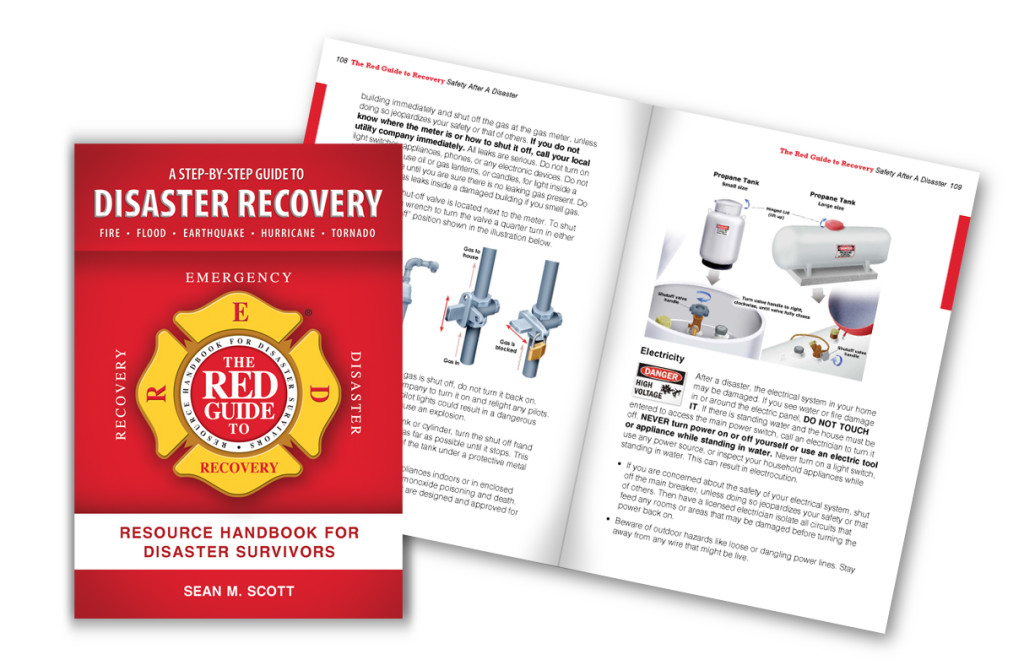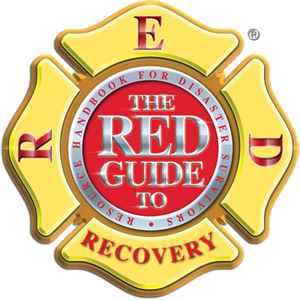Information-rich chapters in The Red Guide to Recovery provide highly detailed insights, facts, and illustrations to aid the disaster survivor. Content highlights include the following topics:
 Chapter 1. Emergency Services
Chapter 1. Emergency Services
- To help with decisions likely to present themselves immediately after first responders leave, this chapter outlines critical steps required in the midst of the chaos the disaster survivor faces.
Chapter 2. Displacement and Relocation
- Disasters that leave homes uninhabitable require families to relocate. Guidance, resources and tips for relocation and temporary housing, how to locate friends, family, and pets are found in this chapter along with tips on cellular phone use.
Chapter 3. Disaster Relief and Financial Assistance
- Information on how to find and apply for needed support services or assistance, and financial aid are provided. Insight to the relief agencies who provide valuable services after a disaster are covered.
Chapter 4. Homeowners and Renters Insurance Information
- This chapter provide practical assistance for the homeowner or renter to help understand some of the important details of the complex insurance claim process.
Chapter 5. Personal Property
- The personal property chapter gives in-depth details on how to handle your personal belongings, as well as how to prepare a personal property inventory.
Chapter 6. Smoke and Water Damage
- The impact of smoke and water damage is often a shock to experience for the first time. This chapter offers tips to protect and mitigate damages resulting from smoke or water damage.
Chapter 7. Estimating the Cost of Repairs
- Tips on estimating repairs includes the critical process of obtaining an accurate scope of work and repair costs to get the needed funds to restore property to its pre-loss condition.
Chapter 8. Selecting a Contractor
- Selecting a contractor is one of the key components in the recovery process. This chapter highlights issues homeowners need to consider before signing any contracts and provides tips on how to select the right contractor to repair or rebuild a home.
Chapter 9. Public Insurance Adjusters
- As with selecting a contractor for services, choosing whether or not to hire representation to assist in the settlement of an insurance claim can be another critical decision. This chapter explains what public adjusters do, how they are paid, and other important facts to educate homeowners on the risks of retaining their services.
Chapter 10. Hazardous Materials
- This chapter identifies some common toxic materials that may be found in, or around, your home. Included are suggestions to minimize risks and how to address these materials safely, including household chemicals, asbestos products, and lead-based paints.
Chapter 11. Safety After a Disaster
- Here we go to the heart of personal safety after a disaster to describe the precautions that must be taken before entering a damaged structure, reestablishing utilities, making sure food and water are safe, and a wide range of other important topics.
Chapter 12. Recovering Valuables
- An often overlooked subject, this chapter shares on how to recover valuable documents and who to contact to replace them. This chapter also offers tips on sifting through debris and ash.
Chapter 13. Trauma Intervention and Grief Counseling
- Most disaster survivors will experience an incredible amount of stress after a traumatic event like a disaster. This chapter provides information regarding trauma intervention, including tips on helping children cope with post-disaster trauma.
Chapter 14. Avoiding Disaster Scams
- Scam artists are often the first on the scene after a disaster. Tips to identify post-disaster scams, as well as valuable information to protect yourself and your family from con artists, are provided.
